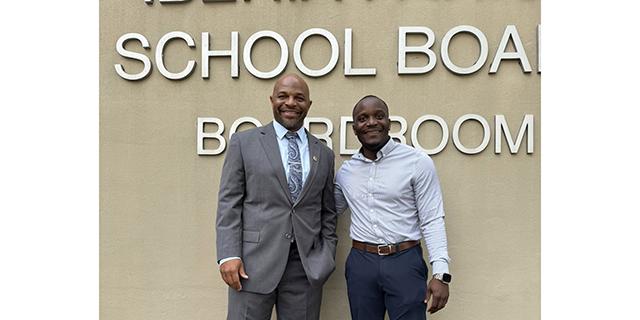Making the Grade
Published 5:00 am Sunday, April 9, 2017

- Every year each grade level at Epiphany Day School comes up with a theme for its harvest party pumpkin. Students contribute and collaborate and the pumpkins are then sold at a silent auction to raise money for the school. Kindergarteners designed the gumball machine.
18 Louisiana Schools are A+
Thanks to the George Rodrigue Foundation of the Arts, 18 Louisiana schools have a new way of teaching that is inspiring children to learn. Not everyone processes information the same way, particularly if a child is creatively inclined as George Rodrigue was in his early years in New Iberia.
Well known around the world as an artist painting dark live oaks with white figures of family, politicians, sports figures and the infamous blue dog — Loup-Garou — Rodrigue’s greatest legacy may yet be the arts foundation that bears his name.
Led by his youngest son Jacques Rodrigue, the foundation recently awarded $46,000 in scholarship money to 16 junior and senior students from throughout Louisiana. The annual awards have contributed more than $350,000 to further the education of youth regardless of their pursuit of art as a profession, plus more than $200,000 in art supplies to schools through George’s Art Closet.
The New Iberia exhibition of George Rodrigue’s Shiny Blue Dog is on loan from the foundation and was introduced at the Bayou Teche Museum gala earlier this year when a new permanent exhibit was unveiled. After Wendy Wolfe Rodrigue closed their Carmel home, the Rodrigue family chose New Iberia to donate the artist’s personal effects including the last painting he was working on at his easel.
“George loved New Iberia and I wanted to honor his request to be buried here,” Wendy Wolfe Rodrigue said. “It seemed only right to bring the studio here where he learned to paint.”
George Rodrigue passed away Dec. 14, 2013 at the age of 69. His battle with cancer seemed like a victory only days before the end. It is Wendy Rodrigue’s goal to honor his legacy by continuing to present his works in ways that bring joy and awareness to new generations of art patrons and students. Visiting schools has been a joy not only for her, but the foundation that bears his name.
Tricentennial Poster
Residents of Louisiana will become very familiar with the artwork of Justin Kimes as his award winning poster circulates in the coming months promoting New Orleans’ Tricentennial celebration. The Shreveport senior high school student won the George Rodrigue Foundation for the Arts 2017 Art Contest with his “Vintage Orleans” design.
The theme for this year’s competition was chosen to give exposure to the winner’s representation of 300 years of the host city’s history. Sixteen entries vied for the honor and the winner received a $6,000 scholarship toward his education.
New Orleans is not the only beneficiary of the arts programs established by the foundation. Eighteen schools throughout the state are now part of Louisiana A+ Schools. Only four states are part of the 20 year practice of providing an effective whole school arts integration model through professional development for educators.
Ephiphany Day School in New Iberia was one of the first six schools in the state to launch the program. It is now a fully functioning arts integrated school having completed a three year commitment with the program.
EDS at ArtWalk
Sabrina Beach, admissions and development director at Epiphany Day School, has had two children attend EDS. They are now in college and ninth grade. She has seen first hand the effects of their school becoming a Louisiana A+ School.
“We received our accreditation four years ago and basically use the arts, both visual and performing arts, to teach all disciplines — math, social studies, science, English, writing — because it provides for our teachers a differentiation,” said Beach. “They are approaching students from a different perspective based on what that student’s strengths are so they can learn everything they need to learn, well.”
As an example, at the 2016 fall ArtWalk in downtown New Iberia, Beach explained the art objects on display. Each of the three-dimensional sculptures was actually an English and math project. Each student was asked to pick an object such as a necklace or basketball goal and then learn how to use geometry to sketch and plan a blueprint for their art object.
The student then looked for “found objects,” a recycling lesson, and the art teacher helped them to build their interpreted object. Finally the student gave a presentation about how the piece came to be and wrote an “ode,” or poem, to the object. One line from each ode was incorporated into the artwork.
“It was a math lesson, a writing lesson and a reading lesson because they had to learn what an ode was and about recycling,” Beach said. “So they repurposed objects, found objects, in order to create their piece. That’s what art integration is about. You take one project and base all these other standard disciplines around it.”
Beach said they’ve always had art enrichment at Epiphany, but art integration is different — it is when those disciplines are used as part of the learning process. Engineers, architects and other professions not traditionally considered creative arts, are foundationally a creative process, she said.
They also created a Hunt Slonem exhibit with the help of a former teacher, Becky Collins, who also helped get the A+ Schools accreditation. Slonem’s art has been part of the Pre-K3 through fifth grade program for years, Beach said.
Always Around the Arts
The arts are a significant teaching tool, said Bethany France, director of Louisiana A+ Schools, especially for English as a second language learners in Louisiana whose first introduction to the language usually has been TV.
Originally from Boston, France came to Louisiana as a teacher through Teach for America. She became the director of mentoring for the Big Buddy Program before moving into the Lieutenant Governor’s office as the director of arts. She was a communications and women’s studies major, but both of her brothers are artists. Brother Chris is the art and gallery director for the Louisiana School for Art Math and Science, the state’s residential program for gifted and talented students.
“Art has always been a part of our family,” France said. “My mother always joked that I was born without the talent — it’s Excel spreadsheets — but I was born to keep my brothers organized.”
France said in Louisiana A+ Schools its not about cultivating artists, its about using the artistic process in learning how to be able to edit and receive constructive criticism and being part of a process that isn’t always perfect in order to achieve perfection.
“From Pre-K3 through 12th grade, that’s what it’s all about,” France said. “The creation of the art is great, it’s wonderful for children and parents to feel proud of it, but it’s the process that’s teaching them the critical thinking skills that they need to be successful today.”
The program has experts that work on professional development for teachers, such as how to use a (Bayou Teche) museum as curriculum, and how to lead meaningful field trips. Architecture, like Shadows-on-the-Teche, also ties into the curriculum, said France.
Teaching Style
There is no curriculum. In A+ Schools, everything is customized to meet the needs of the teachers. At least 85 percent of the educators at a specific school come to the foundation for a five day summer institute bringing with them their own curriculum. The foundation then maps that curriculum to look for the natural connections for the arts in order to progress student learning. Then, they create lesson plans based on what the school is doing.
“We know that if you give a teacher a binder, when the door is closed in their room, they’re going to teach how they teach. So we’re really talking about changing teacher pedagogue to reach every type of learner. That’s what the arts allows for,” France said.
A+ facilitators introduce an artistic discipline — dance, drama, visual arts, whatever — for 90 minutes so teachers experience that art form. Then they have educators already using the A+ methods come in and demonstrate a lesson. The teachers in training pull out their curriculum and together they figure a way to use the arts in the classroom.
“It’s a model that works in all kinds of schools because it is customized,” France said.
Not a National Program
In order to be part of A+ Schools, the faculty of a school has to vote and at least 85 percent of the teachers have to want to program. It cannot be mandated by the principal, state or federal government.
Initially the leadership team is introduced to the program, who then take it back to the schools introducing the program to the teachers. If 85 to 100 percent agree and want the program, the foundation comes along side the school for a committed three-year program customizing curriculum to the needs of the staff, the students and the program being instituted.
Each school is treated separately at the summer institute. Day one is created based on interviews and reviews. Day two and beyond is a result of the interaction between the school and the advisors from the A+ Schools program based on what was learned from the teachers the first day.
It’s customized day by day for each school. There are now 18 schools in the program and it is a three year commitment by the school and from the program. Epiphany Day School, a “graduate” of the program, is operating in its fourth year. It may take up to three years to see the effect of the program, France said.
Progress With Roots
The A+ Schools concept is a 20-year program that started in North Carolina. Oklahoma, Arkansas and Louisiana are the only other states using the arts program in approximately 180 schools. Switzerland is starting this year and South Africa is in its second year. As part of the A+ consortium, program implementers like France meet four times a year to discuss best practices and critique each other’s work. It also provides for a pool of resources connecting teachers across state lines.
“We had six schools start in year one. Kathleen O’Shaughnessy (former principle at EDS) is a very progressive thinker. The more she heard about this, the more she realized it was just good teaching,” France said. “They were willing to learn with us. The six (collectively) went from failing poor schools to a number one public school, private, charter school, parochial, a snapshot of the kinds of schools that can benefit from the program. Very exciting.”
George Rodrigue in Schools
France said it’s all thanks to the Rodrigue family and a team who spent time in schools donating art supplies and painting with the children. The more time they spent in school, the more they realized there was a big issue with education and how the arts could fix that issue.
“They started looking at national models and found A+ School,” France said. “Jacques (Rodrigue) will tell you when he walked into an Oklahoma A+ School the first time, he knew immediately something was different. There was joy, laughter, students were singing and dancing. There was just this happiness he wasn’t feeling in other schools. Teachers were happy to be there. In A+ Schools, teacher and student absentees go down. They want to be at school.”
In the Oklahoma school system, a university connection made the program possible. Without that connection in Louisiana, the Rodrigue Foundation decided to start it on their own.
One of the A+ Schools that started the first year is the one where France had her children enrolled in Baton Rouge. She not only has the benefit of seeing success as one of the organizers, as a parent she has seen first hand the advantage of watching her children grow through arts in education.
“I have a daughter who education comes very easy for her and a son that struggles,” France said. “I’ve seen how it works for both of them. It’s really been interesting. Personally to see their growth because of A+ Schools has been awesome.”
There is something else France has seen benefitting students. As they go from one classroom to another, students realize the teachers have talked with one another about what is being taught. There is a connection.
“Teachers don’t usually have time to talk to one another and we require it,” France said. “We have a principal master scheduler sit with them and work with teachers and principals to teach them how to find that time for collaboration. It is so important.”
The Legacy Continues
New Iberia has embraced the worldwide legacy of James Lee Burke by establishing Dave Robicheaux’s Hometown Literary Festival. Teche Area residents annually celebrate Bunk Johnson with a jazz festival in his honor. Another native son now joins the ranks of famous artists to be celebrated all year long.
Not only has his studio become a permanent part of the Bayou Teche Museum, along with custodianship of the “Saga of the Acadians” collection, but George Rodrigue’s legacy will continue to impact generations to come through the power of art.
There is more to say about George’s Art Closet, his print donation program for charities that helped nearly 800 organizations raise nearly $3 million since 2009. Reenactments of the famous Rodrigue Aioli dinner is now the Aioli Dinner Supper Club helping raise money for the Louisiana A+ School program at a four-course dinner. The Rodrigue spectrum is not yet complete. Everyone can play a part in its completion.
Stop by and see the Shiny Blue Dog exhibit and George’s studio at the Bayou Teche Museum during regular hours and visit the GeorgeRodrigueFoundation.org website.
On another note, Jacques Rodrigue is in the process of archiving the early works of his father. If you own a Rodrigue but are uncertain if it has ever been professionally photographed and archived by the Rodrigue family, contact the foundation at (504) 324-9614 to discuss your painting.
There are those who have said they bought early Rodrigue for pennies, or they could have bought Rodrigue in the early years. It’s not about whether they liked them or didn’t like them, and there have been both, but it is those who made an early investment that helped school children across the state reap the rewards of Rodrigue, the legend.
Those same patrons are encouraged to plant seeds by supporting the George Rodrigue Foundation for the Arts so that others with creative hearts can continue to build their own legacy. After all, the fruit of an artist is not what he creates for himself in amassing fame and wealth, but rather the legacy he leaves as inspiration for future generations. George Rodrigue has done both.





